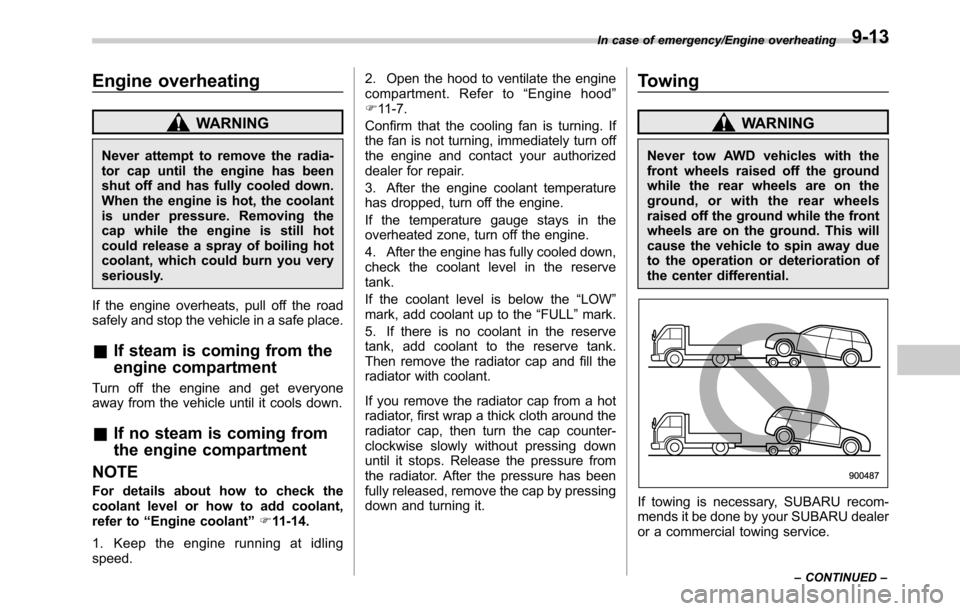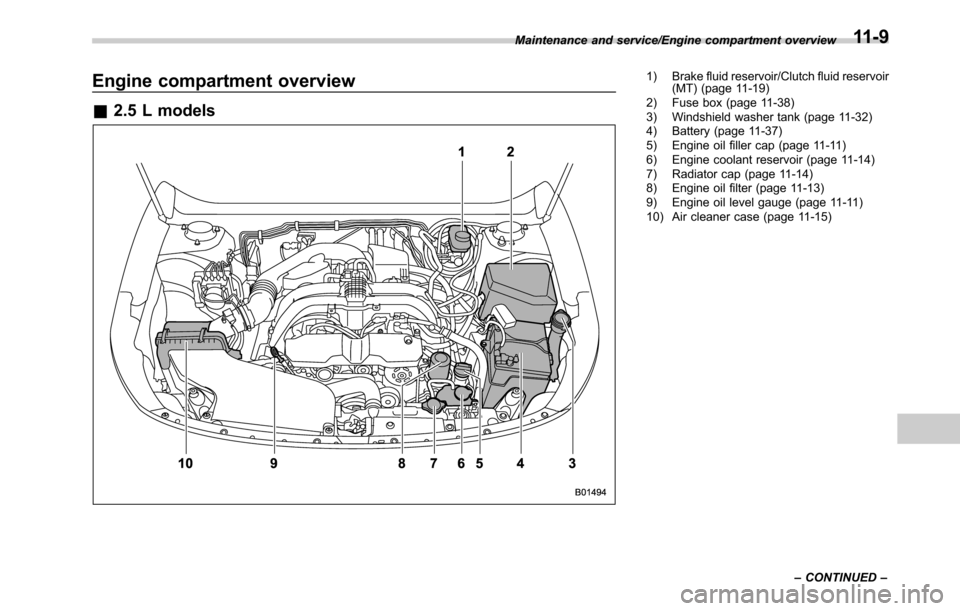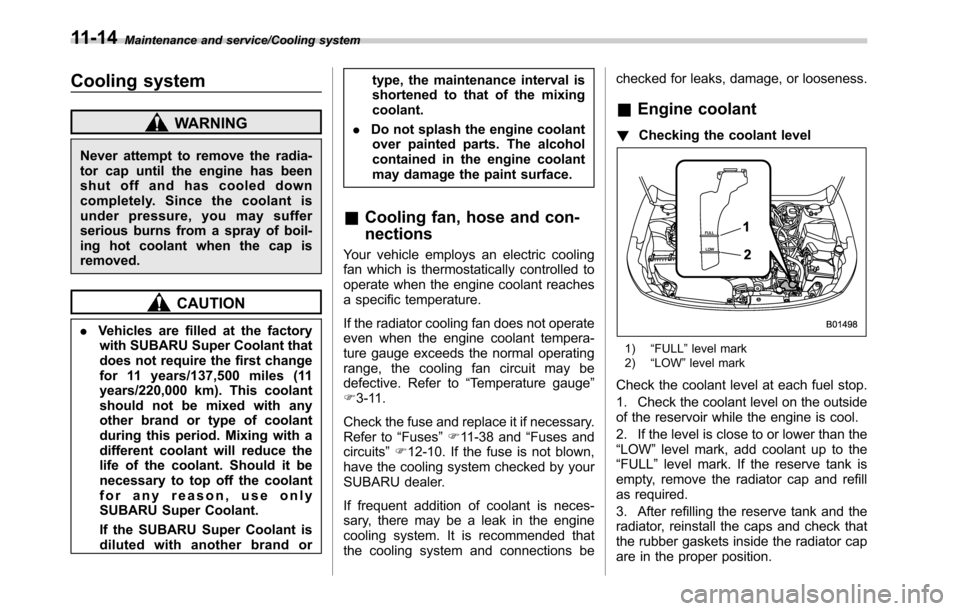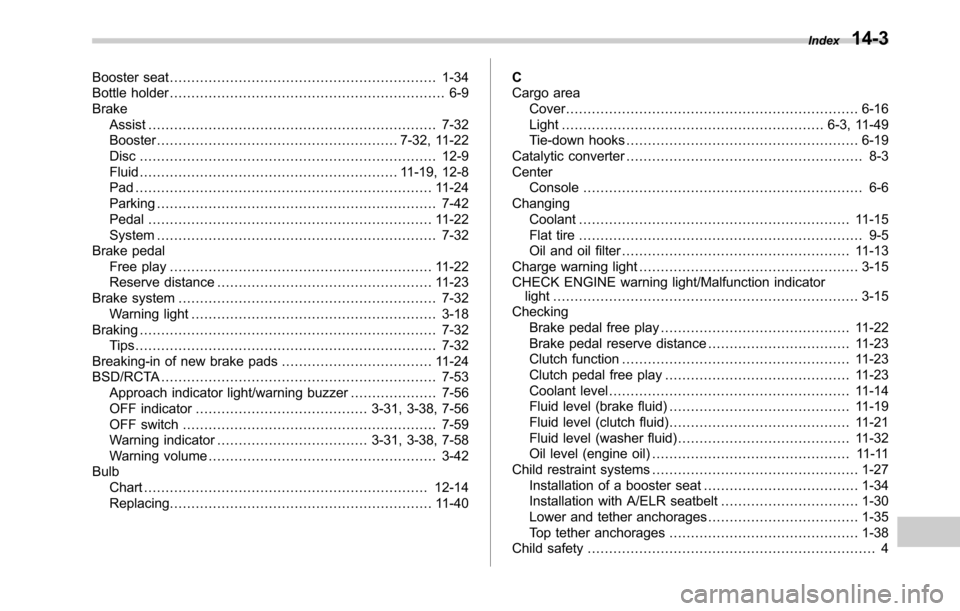coolant level SUBARU OUTBACK 2016 6.G Owners Manual
[x] Cancel search | Manufacturer: SUBARU, Model Year: 2016, Model line: OUTBACK, Model: SUBARU OUTBACK 2016 6.GPages: 572, PDF Size: 21.79 MB
Page 357 of 572

CAUTION
Trapping small animals in the cool-
ing fan and belts of the engine may
result in a malfunction. Check that
no small animal enters the engine
compartment and under the vehicle
before starting the engine.
NOTE
Engine oil, engine coolant, brake fluid,
washer fluid and other fluid levels
should be checked daily, weekly or at
fuel stops.
Starting and stopping the
engine (models without
push-button ignition switch)
&Starting engine
CAUTION
Do not operate the starter motor
continuously for more than 10 sec-
onds. If the engine fails to start after
operating the starter for 5 to 10
seconds, wait for 10 seconds or
more before trying again.
NOTE
It may be difficult to start the engine
when the battery has been discon-
nected and reconnected (for mainte-
nance or other purposes). This diffi-
culty is caused by the electronically
controlled throttle’s self-diagnosis
function. To overcome it, keep the
ignition switch in the“ON”position
for approximately 10 seconds before
starting the engine.!General precautions when starting
engine
WARNING
.Never start the engine from out-
side the vehicle (except when
using the remote engine start
system). It may result in an
accident.
.Do not leave the engine running
in locations with poor ventilation,
such as a garage and indoors.
The exhaust gas may enter the
vehicle or indoors, and it may
result in carbon monoxide poi-
soning.
.Do not start the engine near dry
foliage, paper, or other flam-
mable substances. The exhaust
pipe and exhaust emissions can
create a fire hazard at high
temperatures.
CAUTION
.If the engine is stopped during
driving, the catalyst may over-
heat and burn.
.When starting the engine, be sure
to sit in the driver’s seat (except
Starting and operating/Starting and stopping the engine (models without push–button ignition switch)
–CONTINUED–7-9
Page 451 of 572

Engine overheating
WARNING
Never attempt to remove the radia-
tor cap until the engine has been
shut off and has fully cooled down.
When the engine is hot, the coolant
is under pressure. Removing the
cap while the engine is still hot
could release a spray of boiling hot
coolant, which could burn you very
seriously.
If the engine overheats, pull off the road
safely and stop the vehicle in a safe place.
&If steam is coming from the
engine compartment
Turn off the engine and get everyone
away from the vehicle until it cools down.
&If no steam is coming from
the engine compartment
NOTE
For details about how to check the
coolant level or how to add coolant,
refer to“Engine coolant”F11-14.
1. Keep the engine running at idling
speed.2. Open the hood to ventilate the engine
compartment. Refer to“Engine hood”
F11-7.
Confirm that the cooling fan is turning. If
the fan is not turning, immediately turn off
the engine and contact your authorized
dealer for repair.
3. After the engine coolant temperature
has dropped, turn off the engine.
If the temperature gauge stays in the
overheated zone, turn off the engine.
4. After the engine has fully cooled down,
check the coolant level in the reserve
tank.
If the coolant level is below the“LOW”
mark, add coolant up to the“FULL”mark.
5. If there is no coolant in the reserve
tank, add coolant to the reserve tank.
Then remove the radiator cap and fill the
radiator with coolant.
If you remove the radiator cap from a hot
radiator, first wrap a thick cloth around the
radiator cap, then turn the cap counter-
clockwise slowly without pressing down
until it stops. Release the pressure from
the radiator. After the pressure has been
fully released, remove the cap by pressing
down and turning it.
Towing
WARNING
Never tow AWD vehicles with the
front wheels raised off the ground
while the rear wheels are on the
ground, or with the rear wheels
raised off the ground while the front
wheels are on the ground. This will
cause the vehicle to spin away due
to the operation or deterioration of
the center differential.
If towing is necessary, SUBARU recom-
mends it be done by your SUBARU dealer
or a commercial towing service.
In case of emergency/Engine overheating
–CONTINUED–9-13
Page 469 of 572

Maintenance schedule....................................... 11-3
Maintenance precautions................................... 11-3
Before checking or servicing in the engine
compartment.................................................... 11-4
When checking or servicing in the engine
compartment (2.5 L models)............................. 11-5
When checking or servicing in the engine
compartment while the engine is running.......... 11-5
Maintenance tips................................................ 11-5Removing and reinstalling clips.......................... 11-5
Engine hood....................................................... 11-7
Engine compartment overview.......................... 11-9
2.5 L models...................................................... 11-9
3.6 L models.................................................... 11-10
Engine oil.......................................................... 11-11Engine oil consumption.................................... 11-11
Checking the oil level....................................... 11-11
Changing the oil and oil filter............................ 11-13
Recommended grade and viscosity.................. 11-13
Synthetic oil..................................................... 11-13
Cooling system................................................ 11-14
Cooling fan, hose and connections................... 11-14
Engine coolant................................................. 11-14
Air cleaner element.......................................... 11-15Replacing the air cleaner element..................... 11-15
Spark plugs...................................................... 11-18Recommended spark plugs.............................. 11-18
Drive belts........................................................ 11-18
Manual transmission oil.................................. 11-18
Recommended grade and viscosity.................. 11-18
Continuously variable transmission fluid...... 11-19
Front differential gear oil (CVT models) and
rear differential gear oil................................ 11-19
Recommended grade and viscosity.................. 11-19
Brake fluid........................................................ 11-19Checking the fluid level.................................... 11-19
Recommended brake fluid............................... 11-21
Clutch fluid (MT models)................................. 11-21Checking the fluid level.................................... 11-21
Recommended clutch fluid............................... 11-22
Brake booster.................................................. 11-22
Brake pedal...................................................... 11-22
Checking the brake pedal free play.................. 11-22
Checking the brake pedal reserve distance....... 11-23
Clutch pedal (MT models)............................... 11-23Checking the clutch function............................ 11-23
Checking the clutch pedal free play.................. 11-23
Replacement of brake pad.............................. 11-24Breaking-in of new brake pads ......................... 11-24
Tires and wheels.............................................. 11-24Types of tires................................................... 11-24
Tire pressure monitoring system (TPMS) (if
equipped)...................................................... 11-25
Tire inspection................................................. 11-26
Tire pressures and wear.................................. 11-27
Wheel balance................................................. 11-28
Wear indicators............................................... 11-29
Tire rotation direction mark.............................. 11-29
Tire rotation..................................................... 11-29
Tire replacement.............................................. 11-30
Maintenance and service
11
Page 477 of 572

Engine compartment overview
&2.5 L models
1) Brake fluid reservoir/Clutch fluid reservoir
(MT) (page 11-19)
2) Fuse box (page 11-38)
3) Windshield washer tank (page 11-32)
4) Battery (page 11-37)
5) Engine oil filler cap (page 11-11)
6) Engine coolant reservoir (page 11-14)
7) Radiator cap (page 11-14)
8) Engine oil filter (page 11-13)
9) Engine oil level gauge (page 11-11)
10) Air cleaner case (page 11-15) Maintenance and service/Engine compartment overview
–CONTINUED–
11-9
Page 478 of 572

Maintenance and service/Engine compartment overview
&3.6 L models1) Brake fluid reservoir (page 11-19)
2) Fuse box (page 11-38)
3) Windshield washer tank (page 11-32)
4) Battery (page 11-37)
5) Engine oil filler cap (page 11-11)
6) Engine coolant reservoir (page 11-14)
7) Radiator cap (page 11-14)
8) Engine oil level gauge (page 11-11)
9) Air cleaner case (page 11-15)
11-10
Page 482 of 572

Maintenance and service/Cooling system
Cooling system
WARNING
Never attempt to remove the radia-
tor cap until the engine has been
shut off and has cooled down
completely. Since the coolant is
under pressure, you may suffer
serious burns from a spray of boil-
ing hot coolant when the cap is
removed.
CAUTION
.Vehicles are filled at the factory
with SUBARU Super Coolant that
does not require the first change
for 11 years/137,500 miles (11
years/220,000 km). This coolant
should not be mixed with any
other brand or type of coolant
during this period. Mixing with a
different coolant will reduce the
life of the coolant. Should it be
necessary to top off the coolant
for any reason, use only
SUBARU Super Coolant.
If the SUBARU Super Coolant is
diluted with another brand ortype, the maintenance interval is
shortened to that of the mixing
coolant.
.Do not splash the engine coolant
over painted parts. The alcohol
contained in the engine coolant
may damage the paint surface.
&Cooling fan, hose and con-
nections
Your vehicle employs an electric cooling
fan which is thermostatically controlled to
operate when the engine coolant reaches
a specific temperature.
If the radiator cooling fan does not operate
even when the engine coolant tempera-
ture gauge exceeds the normal operating
range, the cooling fan circuit may be
defective. Refer to“Temperature gauge”
F3-11.
Check the fuse and replace it if necessary.
Refer to“Fuses”F11-38 and“Fuses and
circuits”F12-10. If the fuse is not blown,
have the cooling system checked by your
SUBARU dealer.
If frequent addition of coolant is neces-
sary, there may be a leak in the engine
cooling system. It is recommended that
the cooling system and connections bechecked for leaks, damage, or looseness.
&Engine coolant
!Checking the coolant level
1)“FULL”level mark
2)“LOW”level mark
Check the coolant level at each fuel stop.
1. Check the coolant level on the outside
of the reservoir while the engine is cool.
2. If the level is close to or lower than the
“LOW”level mark, add coolant up to the
“FULL”level mark. If the reserve tank is
empty, remove the radiator cap and refill
as required.
3. After refilling the reserve tank and the
radiator, reinstall the caps and check that
the rubber gaskets inside the radiator cap
are in the proper position.
11-14
Page 557 of 572

Booster seat.............................................................. 1-34
Bottle holder................................................................ 6-9
Brake
Assist................................................................... 7-32
Booster........................................................ 7-32, 11-22
Disc..................................................................... 12-9
Fluid............................................................ 11-19, 12-8
Pad ..................................................................... 11-24
Parking................................................................. 7-42
Pedal.................................................................. 11-22
System................................................................. 7-32
Brake pedal
Free play............................................................. 11-22
Reserve distance.................................................. 11-23
Brake system............................................................ 7-32
Warning light......................................................... 3-18
Braking..................................................................... 7-32
Tips...................................................................... 7-32
Breaking-in of new brake pads................................... 11-24
BSD/RCTA................................................................ 7-53
Approach indicator light/warning buzzer.................... 7-56
OFF indicator........................................ 3-31, 3-38, 7-56
OFF switch........................................................... 7-59
Warning indicator................................... 3-31, 3-38, 7-58
Warning volume..................................................... 3-42
Bulb
Chart.................................................................. 12-14
Replacing............................................................. 11-40C
Cargo area
Cover.................................................................... 6-16
Light............................................................. 6-3, 11-49
Tie-down hooks...................................................... 6-19
Catalytic converter....................................................... 8-3
Center
Console................................................................. 6-6
Changing
Coolant............................................................... 11-15
Flat tire.................................................................. 9-5
Oil and oil filter..................................................... 11-13
Charge warning light................................................... 3-15
CHECK ENGINE warning light/Malfunction indicator
light....................................................................... 3-15
Checking
Brake pedal free play............................................ 11-22
Brake pedal reserve distance................................. 11-23
Clutch function..................................................... 11-23
Clutch pedal free play........................................... 11-23
Coolant level........................................................ 11-14
Fluid level (brake fluid).......................................... 11-19
Fluid level (clutch fluid).......................................... 11-21
Fluid level (washer fluid)........................................ 11-32
Oil level (engine oil).............................................. 11-11
Child restraint systems................................................ 1-27
Installation of a booster seat.................................... 1-34
Installation with A/ELR seatbelt................................ 1-30
Lower and tether anchorages
................................... 1-35
Top tether anchorages............................................ 1-38
Child safety................................................................... 4
Index14-3
Page 559 of 572

Winter.................................................................... 8-8
E
ECO gauge............................................................... 3-11
Electrical system........................................................ 12-9
Electronic Brake Force Distribution (EBD) system.......... 7-34
Warning................................................................ 3-19
Electronic parking brake.............................................. 7-42
Automatic release function by accelerator pedal......... 7-44
Hill Holder............................................................. 7-45
Indicator light......................................................... 3-20
Warning........................................................ 3-20, 7-47
Emergency Locking Retractor (ELR)............................. 1-17
Engine
Compartment overview........................................... 11-9
Coolant........................................................ 11-14, 12-8
Exhaust gas (carbon monoxide)............................. 5, 8-2
Hood.................................................................... 11-7
Low oil level warning indicator................................. 3-16
Oil............................................................... 11-11, 12-4
Overheating.......................................................... 9-13
Starting & stopping........................................... 7-9, 7-12
Event data recorder......................................................... 8
Exterior care.............................................................. 10-2
F
Flat tires..................................................................... 9-5
Floor mat.................................................................. 6-15
Fluid level
Brake.................................................................. 11-19
Clutch.................................................................. 11-21Continuously variable transmission......................... 11-19
Fog light
Bulb.......................................................... 11-42, 12-14
Indicator light......................................................... 3-31
Steering responsive fog lights system....................... 3-49
Switch................................................................... 3-49
Front
Differential gear oil........................................ 11-19, 12-7
Seatbelt pretensioners............................................ 1-24
Side marker light.................................................. 11-42
Turn signal light.................................................... 11-42
Front seats................................................................. 1-2
Forward and backward adjustment............................ 1-4
Head restraint adjustment......................................... 1-8
Memory function...................................................... 1-6
Power seat............................................................. 1-5
Reclining................................................................ 1-4
Seat height adjustment (driver’s seat)........................ 1-4
Fuel........................................................................... 7-3
Consumption indicator............................................. 3-36
Economy hints........................................................ 8-2
Filler lid and cap...................................................... 7-4
Gauge................................................................... 3-10
Requirements................................................. 7-3, 12-3
Fuses
..................................................................... 11-38
Fuses and circuits.................................................... 12-10
G
GAWR (Gross Axle Weight Rating) ............................... 8-14
Glove box................................................................... 6-6
GVWR (Gross Vehicle Weight Rating)........................... 8-14
Index14-5